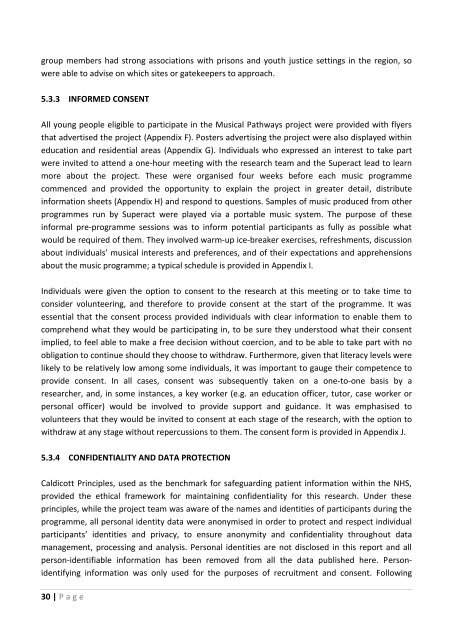De Viggiani, N., Daykin, N., Moriarty, Y. and Pilkington, P. and ...
De Viggiani, N., Daykin, N., Moriarty, Y. and Pilkington, P. and ...
De Viggiani, N., Daykin, N., Moriarty, Y. and Pilkington, P. and ...
Create successful ePaper yourself
Turn your PDF publications into a flip-book with our unique Google optimized e-Paper software.
group members had strong associations with prisons <strong>and</strong> youth justice settings in the region, so<br />
were able to advise on which sites or gatekeepers to approach.<br />
5.3.3 INFORMED CONSENT<br />
All young people eligible to participate in the Musical Pathways project were provided with flyers<br />
that advertised the project (Appendix F). Posters advertising the project were also displayed within<br />
education <strong>and</strong> residential areas (Appendix G). Individuals who expressed an interest to take part<br />
were invited to attend a one-hour meeting with the research team <strong>and</strong> the Superact lead to learn<br />
more about the project. These were organised four weeks before each music programme<br />
commenced <strong>and</strong> provided the opportunity to explain the project in greater detail, distribute<br />
information sheets (Appendix H) <strong>and</strong> respond to questions. Samples of music produced from other<br />
programmes run by Superact were played via a portable music system. The purpose of these<br />
informal pre-programme sessions was to inform potential participants as fully as possible what<br />
would be required of them. They involved warm-up ice-breaker exercises, refreshments, discussion<br />
about individuals’ musical interests <strong>and</strong> preferences, <strong>and</strong> of their expectations <strong>and</strong> apprehensions<br />
about the music programme; a typical schedule is provided in Appendix I.<br />
Individuals were given the option to consent to the research at this meeting or to take time to<br />
consider volunteering, <strong>and</strong> therefore to provide consent at the start of the programme. It was<br />
essential that the consent process provided individuals with clear information to enable them to<br />
comprehend what they would be participating in, to be sure they understood what their consent<br />
implied, to feel able to make a free decision without coercion, <strong>and</strong> to be able to take part with no<br />
obligation to continue should they choose to withdraw. Furthermore, given that literacy levels were<br />
likely to be relatively low among some individuals, it was important to gauge their competence to<br />
provide consent. In all cases, consent was subsequently taken on a one-to-one basis by a<br />
researcher, <strong>and</strong>, in some instances, a key worker (e.g. an education officer, tutor, case worker or<br />
personal officer) would be involved to provide support <strong>and</strong> guidance. It was emphasised to<br />
volunteers that they would be invited to consent at each stage of the research, with the option to<br />
withdraw at any stage without repercussions to them. The consent form is provided in Appendix J.<br />
5.3.4 CONFIDENTIALITY AND DATA PROTECTION<br />
Caldicott Principles, used as the benchmark for safeguarding patient information within the NHS,<br />
provided the ethical framework for maintaining confidentiality for this research. Under these<br />
principles, while the project team was aware of the names <strong>and</strong> identities of participants during the<br />
programme, all personal identity data were anonymised in order to protect <strong>and</strong> respect individual<br />
participants’ identities <strong>and</strong> privacy, to ensure anonymity <strong>and</strong> confidentiality throughout data<br />
management, processing <strong>and</strong> analysis. Personal identities are not disclosed in this report <strong>and</strong> all<br />
person-identifiable information has been removed from all the data published here. Personidentifying<br />
information was only used for the purposes of recruitment <strong>and</strong> consent. Following<br />
30 | P a g e
















